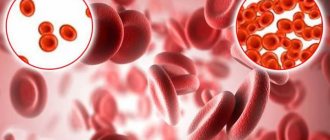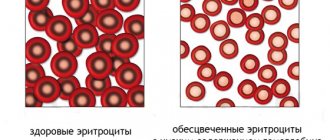Cobalamin deficiency leads to a lack of red blood cells and hemoglobin in the blood, which causes anemia. Acute deficiency occurs in 0.1% of the population; elderly people over 70 years of age are most susceptible to it, among whom low values are detected in every tenth, and B12 deficiency anemia is diagnosed in every hundredth. If therapy is not started in time, pancytopenia is possible - the body will begin to experience a deficiency of various blood elements. Diagnosis and treatment of all types of anemia in Anapa is carried out in a medical clinic.
Symptoms of vitamin B12 deficiency
It is easier to prevent anemia than to treat and restore the body from the damage caused. Symptoms of cobalamin deficiency are easy to detect in yourself or loved ones:
- Against the background of a decrease in hemoglobin and an increase in bilirubin, the skin turns pale and yellowish.
- The heartbeat quickens, stabbing pain in the chest area due to overload is possible.
- Dizziness due to insufficient oxygen supply to the brain.
- Memory impairment, decreased mental abilities.
- Shortness of breath after minor physical exertion.
- Decreased visual acuity, blurred objects, “goosebumps” before the eyes.
- Digestive system disorders: heartburn, increased gas formation, diarrhea, distortion of taste.
- Stomatitis, it says, the tongue is raspberry colored.
- Nervous system disorders: muscle weakness, numbness or tingling of the extremities, impaired coordination of movements, insomnia, convulsions.
It is important to understand that long-term B12 deficiency leads to irreversible neurological changes. Timely identification and elimination of the deficiency normalizes the condition in 1.5-2 months.
Diagnosis of anemia
It is individual, depending on what the doctor sees in the general blood test for this particular patient. Of course, the doctor will understand the reasons that led to anemia and immediately rule out dangerous ones: ulcers and tumors of the stomach and intestines, as well as malignant neoplasms of other localization and dangerous blood diseases, such as leukemia, aplastic anemia.
Reasons for a critical decrease in cobalamin
B12 deficiency anemia occurs when there is insufficient intake of animal protein into the body and in cases where cobalamin is not absorbed and does not enter the blood.
In the first case, people most often suffer who limit themselves in nutrition - losing weight, vegetarians, adherents of methods with an unbalanced diet. B12 is found in meat, beef liver, dairy products, and egg yolks.
The second, endogenous cause requires diagnosis. The absorption of cobalamin is ensured by the enzyme Castle factor. When the synthesis of intrinsic factor Castle decreases or stops, the vitamin that enters the body is not absorbed.
Absorption into the bloodstream is prevented by diseases of the gastrointestinal tract:
- atrophic gastritis,
- chronic pancreatitis,
- Crohn's disease,
- diverticula of the small intestine,
- tumors.
In some hormonal diseases, including hyperthyroidism, B12 consumption increases several times. At the same time, the body experiences a shortage of it even with normal intake and without problems of absorption.
In some cases, the cause of deficiency is helminths and bacteria, taking certain medications and oral contraceptives, and alcoholism. Even frequent intestinal upset can interfere with the absorption of the substance.
Pernicious anemia (B12 deficiency, folate deficiency, megaloblastic)
Terminology
The long, but not complete list of synonymous diagnoses that served as the title of the article requires comment;
Along the way, the content of these terms will also become clearer. What our blood is made of, what its biological role is, what anemia is - the materials “Clinical Blood Test” and “Anemia. Blood and bloodlessness." More information about B vitamins can be found in the articles “Vitamin B. Hypovitaminosis” and “Vitamin B. Hypervitaminosis”.
Pernicious in translation from Latin into Russian means “dangerous”, and in medical translation it means “severe, malignant, prognostically unfavorable”. Megaloblastic (sometimes written “megaloblastic”) means that the bone marrow contains a large number of large cells that are “under-erythrocytes” - one of the intermediate, immature forms of red blood cells.
B12 is a vitamin (it is clear which group), otherwise called the Castle factor and is represented by four different cobalt-containing substances with the same biological properties, which made it possible to distinguish them into a single subgroup of vitamin B.
Folic (literally “leafy”) acid is a vitamin of the same group, namely B9.
Thus, we get: dangerous, malignant B-vitamin deficiency immature erythrocyte anemia. Previously, it was called that: pernicious anemia or pernicious anemia. But it is also called Addison-Biermer's disease or Biermer's anemia, and here's why.
In 1822, the symptoms of a certain serious blood disease were first mentioned by the English physician J.S. Combe. In 1849 , his compatriot, the outstanding physician and scientist Thomas Addison, gave a more detailed description and interpretation. Much later, in 1871 , but independently of Addison, the German researcher Michael Anton Birmer studied and characterized this disease in detail, which he gave the name progressive pernicious anemia.
Later, the American William Murphy intensively sought treatment for anemia (for anemia in general, without nosological division), conducting experiments on artificially bled dogs. Murphy fed them different foods and compared recovery rates; His attention was drawn to the raw liver. Since the 1920s, through the efforts of W. Murphy, J. Whipple and J. Minot, pernicious anemia ceased to be an unambiguously and completely lethal disease: the life-saving medicine lay precisely in the liver. And it all ended with Murphy, Whipple and Minot in 1934 for isolating a substance (a group of compounds, as it turned out) known today as vitamin B12.
In parallel with these works, the American scientist William Bosworth Castle studied anemia, about whom the memorial publication of the US National Academy of Sciences (2018) says: “From a purely descriptive art, he transformed hematology into a dynamic interdisciplinary science.” Among other things, W.B. Castle once subjected himself and a group of volunteer patients to a not very appetizing experiment (involving the ingestion and regurgitation, after an hour, of raw meat, which was then used as a treatment for severe anemia). This strange experiment, however, was a brilliant idea: Castle proved beyond doubt that in order to turn raw meat into real medicine, it must be in the stomach - where a certain processing, activating reagent is contained. This gastric enzyme, gastromucoprotein, is today known throughout the world as “intrinsic Castle factor,” while “extrinsic Castle factor” refers to vitamin B12 itself.
In a series of articles about vitamins, the Lakhta Clinic has repeatedly drawn attention to the fact that the history of the discovery and study of these amazing substances turned out to be very difficult, tortuous, and sometimes dramatic. But humanity in general and medicine in particular are distinguished by incredible self-preservation stubbornness when something truly threatens us. Today, cardiovascular pathology, malignant tumors, viral hepatitis, autoimmune and hereditary diseases are on the agenda. And figuratively speaking, these killers will not hide from us anywhere, just as the plague and leprosy, vitamin deficiencies and anemia did not hide: the true causes will be exposed, the pathogenesis will be thoroughly studied, and cures will be found. Hurry up, gentlemen, scientists. Hurry up. We know that everything imaginable and inconceivable is being done; We know that somewhere in laboratories, clinics, university centers, modern Castles, Addisons, Birmers, Jenners, Mechnikovs, Flemmings are wrinkling their high foreheads and rubbing their eyes, sore from insomnia. Still, hurry up, please...
Returning to the confusing problem of B12-deficiency anemia: pernicious anemia is not a synonym, it is a special case. As is already clear from what has been said, the lack of cobalt-containing vitamins and folic acid in the body can be due to two fundamentally different reasons.
Diagnosis of pernicious anemia
To determine vitamin B12 levels, a biochemical blood test is performed. If the levels are below normal, a lack of cobalamin is noted or a deficiency is diagnosed.
The most important thing in diagnosis is to identify the cause of B12 deficiency anemia. To do this, a number of diagnostic studies are carried out:
- stool analysis for worm eggs;
- Schilling's test - a test of the body's ability to absorb B12 from the intestines;
- gastroscopy – endoscopic examination of the stomach, detection of gastritis, cancer and other diseases;
- colonoscopy – examination of the intestines, detection of tumors;
- X-ray of the stomach;
- Ultrasound of the abdominal organs;
- electroencephalography and MRI of the brain.
The doctor will prescribe those examinations that he considers necessary, taking into account age and concomitant diseases (or if they are suspected).
Main types of anemia
Iron-deficiency anemia
The most common type of anemia is iron deficiency anemia; according to the latest edition of the Oxford handbook of clinical medicine, it affects 14% of women of childbearing age.
Causes of iron deficiency anemia:
— Special diets (for example, vegetarianism)
— Acute blood loss (as a result of wounds and injuries) and chronic (gastrointestinal diseases, ulcers, colon tumors, gastropathy associated with long-term, uncontrolled use of NSAIDs, etc.)
— Malabsorption or poor absorption of iron in the intestine leads to the development of refractory anemia.
— Helminthic infestations, especially in the tropics.
— Pregnancy (if the patient previously had a latent iron deficiency or a special diet).
Diagnosis of iron deficiency anemia anemia
A doctor may suspect anemia by analyzing the patient's complaints (which are often nonspecific and may be a manifestation of other diseases) and the results of the examination, analyzing the condition of the skin, hair, and mucous membranes. During auscultation, the doctor can hear systolic murmur, muffled heart sounds, arrhythmia, and can see changes on the ECG. That's why you shouldn't neglect a doctor's examination! Many people take a general blood test on their own and, having seen the result, start taking iron supplements on their own, without consulting a doctor. You can't do that! It is important not only to cure anemia, increase the level of hemoglobin in the blood, but also to understand the causes of its occurrence and eliminate them. The reasons may be dangerous! (for example, ulcers and tumors of the stomach and intestines).
That’s why, if you ever see reduced hemoglobin or an insufficient number of red blood cells in your blood test, you need to see a doctor as soon as possible!
Anemia during pregnancy
Anemia during pregnancy is often associated with latent iron deficiency before pregnancy, with limited intake of iron and protein from food (toxicosis of 1 half), increased requirements for iron and protein associated with fetal growth.
Therefore, it is more profitable to prepare for pregnancy. Consult a general practitioner, take a general blood test, determine the level of ferritin, serum iron, vitamin B 12, folic acid. If the doctor sees a lack of any vitamins or microelements in the test results, he will immediately prescribe a correction. Because a lack of hemoglobin in the blood of a pregnant woman leads to oxygen starvation of the fetus, increases the number of obstetric complications, such as premature birth, and also increases the risk of developing infection after childbirth!
In order not to worry about the baby, it is better to take care of this before pregnancy. And also take care of yourself. After all, during childbirth, one way or another, blood loss occurs. Therefore, a woman’s anemia may continue after childbirth. She will feel tired, sleepy, but she needs to take care of the baby and breastfeed! Taking iron supplements for nursing mothers is often difficult because An infant develops a rash. That is why it is so important to take care of the prevention of anemia in advance, even before pregnancy!
Hemolytic anemia
Hemolytic anemia is a group of diseases, the common feature of which is increased destruction of red blood cells, which leads to the development of anemia and increased formation of breakdown products of red blood cells, on the other hand, to increased erythropoiesis (formation of red blood cells).
Hemolytic anemias are hereditary (congenital, caused by gene defects) and acquired. This also includes hemolytic anemia of newborns. Hemolytic anemia also occurs as a result of parasitosis such as malaria; it will have a crisis course, with high fever and stunning chills. Therefore, be careful when traveling to areas where malaria is endemic. It is better to consult with an infectious disease doctor in advance and find out how you can avoid infection.
What provokes the development of hemolysis in hemolytic anemia?
— Infections such as parvovirus, rotavirus, norovirus;
- Cold. (with paroxysmal cold hemoglobinuria);
- Taking medications, especially antibiotics, especially on your own, without a doctor’s prescription!
The main symptom that the patient himself or his relatives may notice is jaundice. Sometimes it is dark urine (with paroxysmal hemoglobinuria)
Diagnosis of this type of anemia may require genetic testing.
There are so many types of hemolytic anemia that only a doctor can understand the diagnosis and treatment!
Aplastic anemia
Aplastic anemia is a disease of the hematopoietic system, characterized by inhibition of the hematopoietic function of the bone marrow and manifested by insufficient formation of red blood cells, leukocytes and platelets (panhemocytopenia) or only red blood cells (partial hypoplastic anemia). Aplastic anemia is characterized by severe pancytopenia - anemia, leukopenia, thrombocytopenia and lymphopenia.
It can also be hereditary and acquired. If it is not possible to identify any reasons for the development of aplastic anemia, then such anemia is called idiopathic.
What can lead to the development of aplastic anemia?
— Contact with chemicals (arsenic, aromatic hydrocarbons, in particular benzene, heavy metal salts);
— Ionizing radiation;
— Medicines (NSAIDs, cytostatics, Mercazolil, analgin, chloramphenicol);
— Infectious agents (for example, viruses);
— Autoimmune processes (systemic lupus erythematosus, Sjogren's syndrome).
Therefore, we repeat once again: under no circumstances engage in uncontrolled use of medications! Only by doctor's prescription










